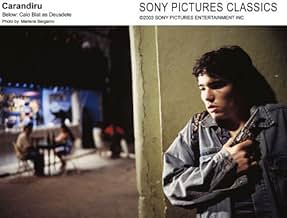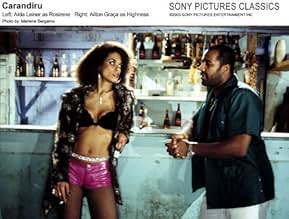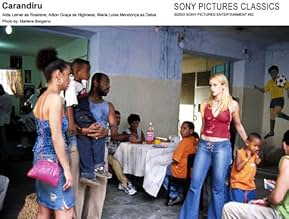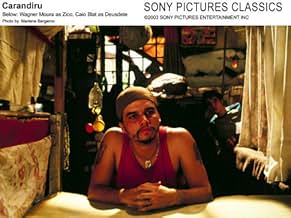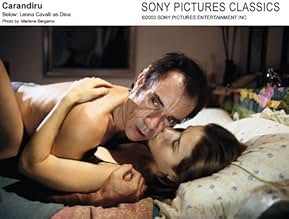Ajouter une intrigue dans votre langueStories of crime, revenge, love, and friendship at the Carandiru Penitentiary, the largest prison in Latin America.Stories of crime, revenge, love, and friendship at the Carandiru Penitentiary, the largest prison in Latin America.Stories of crime, revenge, love, and friendship at the Carandiru Penitentiary, the largest prison in Latin America.
- Réalisation
- Scénario
- Casting principal
- Récompenses
- 16 victoires et 33 nominations au total
- Gilson
- (as Enrique Díaz)
- Rosirene
- (as Aída Leiner)
Avis à la une
Yes, these characters are a handful of long-term convicts in one of largest prisons in the world - 7000 of them, in one (in San Pualo, Brazil), that's designed for 'only' 4,000 and we are introduced to them and their frank, matter-of-fact lives as they describe their drug and sex life 'inside' to the wonderfully open and compassionate doctor ( Luiz Carlos Vasconcelos). It's from his perspective as, part of his training, he's thrown into the deep end as he tries to treat and educate prisoners about AIDS.
Amongst the knowing humour, there are tales of anguish, violence and heartache with the main character's stories being run as flashbacks. Most of the crime is petty but circumstance and poverty has dumped most of these damaged people into one huge melting pot, of squalor, STD's and drugs. One finds it surprisingly easy to be open and impartial about situations that could make your toes curl.
Despite the vivid colours used and the Latin music that gets played in and amongst this tapestry of a human jigsaw, where few of the pieces fit, mounting signs reveal an underbelly of unrest, a pressure-cooker that's about to boil over and when it does and armed police march in, the film turns dark, angry and really hits the viewer. I won't say why, though the closing epilogues do (very) partially redress some of what went on.
This is essential Brazilian drama. Gritty, hard-hitting, yes but if you've got the stomach for the excellent City of God, you'll have no trouble here. Buy it, watch it, you'll feel like a proper human being, I promise you.
In the first place, it should be remarked that it needs a lot of courage to put on screen the beautiful and crude Varella´s book on the day-by-day of prisoners of the Sao Paulo jail Carandiru (once the biggest jail on Brazil, now demolished). In particular the movie shows one the the darkest pages in the recent Brazilian history, namely, the massacre occurred in that jail in October 1992: during a rebellion, the police invaded the prison and killed summarily 111 prisoners. Not a single policeman was even injured during the action.
In order to understand the movie, I think is very important to stress how deep has been the relevance of this sad and cruel event in the slow evolution of the Brazilian society towards less barbarian standards. At the time of the massacre most of the elites, media and middle class supported the police action and only ten years later, in 2001, some of the authors of the massacre has been put on trial. In other words the Carandiru tragic facts of 1992 and the way they have been so differently evaluated here during these years, reveals in a tragic fashion one of the most explosive contradiction of the present Brazilian society, in which a large majority of the Brazilians is completely excluded and plundered.
The movie of Babenco show this clearly and powerfully. Babenco used different kind of approaches. Most of the time the tone of the movie is realistic even bordering a documentary, but there are scenes in which the movie becomes visionary.
I am not surprise that the film was not well accepted in the recent Cannes festival. Critics from the first world are not expected to know much about the actual situation of Brazil (euphemisticly speaking). The fact is that Brazil in the USA/Europe imaginary continues to be unfortunately the country of carnival, football and samba and dark crude point of view such as the one of Babenco tend to be considered as disturbing or worst boring. So, while in the preview session for the press in Cannes 2003 most of the comments were "too long", this nearly three hours movie is one most
seen of the year in Brazil.
The film is being dubbed by some as "this year's City of God", but it's very different to last years Brazillian smash. Where 'City of God' had some very flashy direction and MTV-ized zip-bang editing, 'Carandiru' is pretty straight forward. The film still has some great direction though, Hector Babenco has a leisurely style (matched by his actual output, it's been 7 years since his last film, and nearly 20 since 'Ironweed'), allowing the story the space it needs to breathe but still picking up the pace to build tension. Ironically the only section of the film I didn't really like was the bit that was the most 'City of God'-like. When the doctor is dealing with his patients he asks each one what their story is, and sometimes it's a bit forced, just like in 'City of God' with the "now it's my turn to tell you my story".
Where it's very similar to 'City of God' is it's themes - it's essentially a humanist comedy with a moral edge, dealing with love, hate, revenge, innocence and betrayal. The cons are poor and murderous, but lovable at the same time. If this film and 'City of God' are to believed drug-dealing thieving murderers all have their hearts in the right place and are all okay guys who just took a wrong turn on the road.
There's a bit of a stink being kicked up at the moment on the imdb forum for 'Carandiru'. A lot of Brazillian's are posting, very upset with filmmakers consistently showing Brazil in a negative light. I think that although both films do have that slant to them, they have actually increased interested in the country, and even more so the countries film output, taking it to a global audience. If all Scottish films are to be believed we're all a bunch of Glasweigan Gangster Hardnuts or heroin-addicted thieving murderers too, so I fail to see what the fuss is about.
The director drives home the real point of the film in the last 20 minutes. The overcrowding and in-fighting finally erupts into a full-blown riot that results in the main characters block being taken over by the prisoners. A riot squad enters, and the ensuing rampage is one of the most graphic and genuinely shocking ever committed to film. Definitely not for the faint-of-heart. I remember seeing the prison riot being reported in the UK news, and being appalled at how crowded the prison was, and how a government could let it reach boiling point like that. The last 20 minutes really smacked that home, but with the closing shots of the prison finally being demolished in 2002 you feel like there was at least some sort of closure on the tragedy.
The story is harrowing, but heart-warming, and the acting (mostly from unknowns) is top rate. It's my favorite film of the year so far, but do beware the last 20 minutes, you won't leave the cinema feeling happy.
Le saviez-vous
- AnecdotesDr. Dráuzio Varella wrote the original book at the encouragement of a patient he was treating for lymphatic cancer. That very patient happened to be Hector Babenco, who recovered and went on to direct the film adaptation.
- GaffesDuring the riot, as the inmates are running up the stairs of the cell block shortly after the riot squad has entered, one inmate can be seen wearing a T-Shirt of hip-hop group the Wu-Tang Clan. The group only formed in the year the riot took place (1992), and did not release their first widely available album (36 Chambers - Enter the Wu-Tang) until the following year. It is unlikely they would at this time have had a following in Brazil, nor would merchandise be available.
- Citations
Lady Di: I've come to take the test.
Médico - Physician: Please, take a seat. First, I'd like to ask you a few questions, Lady Di.
Lady Di: I've seen this movie before, doctor. I've never needed a blood transfusion and I never pierce my veins. The only drug I use is a joint now and then... when I watch TV or for a little romance.
Médico - Physician: And partners, how many?
Lady Di: Oh, about 2000.
- ConnexionsFeatured in 2005 Glitter Awards (2005)
Meilleurs choix
- How long is Carandiru?Alimenté par Alexa
Détails
- Date de sortie
- Pays d’origine
- Site officiel
- Langue
- Aussi connu sous le nom de
- Vzbura vo väznici Carandiru
- Lieux de tournage
- Sociétés de production
- Voir plus de crédits d'entreprise sur IMDbPro
Box-office
- Budget
- 12 000 000 R$ (estimé)
- Montant brut aux États-Unis et au Canada
- 216 335 $US
- Week-end de sortie aux États-Unis et au Canada
- 17 945 $US
- 16 mai 2004
- Montant brut mondial
- 10 781 635 $US
- Durée2 heures 25 minutes
- Couleur
- Mixage
- Rapport de forme
- 1.85 : 1
Contribuer à cette page








